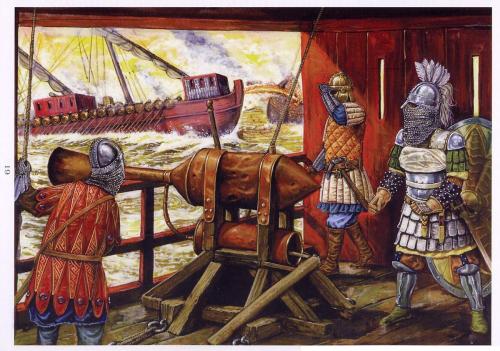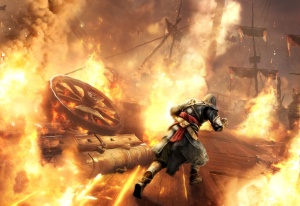It’s all a bit of a blur, isn’t it? That little-remembered
century—1600 to 1700—that began with the founding (and foundering) of
the first permanent English settlement in America, the one called
Jamestown, whose endemic perils portended failure for the dream of a New
World. The century that saw all the disease-ridden, barely civilized
successors to Jamestown slaughtering and getting slaughtered by the
Original Inhabitants, hanging on by their fingernails to some fetid
coastal swampland until Pocahontas saved Thanksgiving. No, that’s not
right, is it? I said it was a blur.
Enter Bernard Bailyn, the greatest historian of early America alive
today. Now over 90 and ensconced at Harvard for more than six decades,
Bailyn has recently published another one of his epoch-making grand
narrative syntheses,
The Barbarous Years, casting a light on
the darkness, filling in the blank canvas with what he’s gleaned from
what seems like every last scrap of crumbling diary page, every
surviving chattel slave receipt and ship’s passenger manifest of the
living and dead, every fearful sermon about the Antichrist that survived
in the blackened embers of the burned-out churches.
Bailyn has not painted a pretty picture. Little wonder he calls it
The Barbarous Years
and spares us no details of the terror, desperation, degradation and
widespread torture—do you really know what being “flayed alive” means?
(The skin is torn from the face and head and the prisoner is
disemboweled while still alive.) And yet somehow amid the merciless
massacres were elements that gave birth to the rudiments of
civilization—or in Bailyn’s evocative phrase, the fragile “integument of
civility”—that would evolve 100 years later into a virtual Renaissance
culture, a bustling string of self-governing, self-sufficient, defiantly
expansionist colonies alive with an increasingly sophisticated and
literate political and intellectual culture that would coalesce into the
rationale for the birth of American independence. All the while
shaping, and sometimes misshaping, the American character. It’s a grand
drama in which the glimmers of enlightenment barely survive the
savagery, what Yeats called “the blood-dimmed tide,” the brutal
establishment of slavery, the race wars with the original inhabitants
that Bailyn is not afraid to call “genocidal,” the full, horrifying
details of which have virtually been erased.
“In truth, I didn’t think anyone sat around erasing it,” Bailyn tells
me when I visit him in his spacious, document-stuffed study in
Harvard’s Widener Library. He’s a wiry, remarkably fit-looking fellow,
energetically jumping out of his chair to open up a file drawer and show
me copies of one of his most-prized documentary finds: the handwritten
British government survey records of America-bound colonists made in the
1770s, which lists the name, origin, occupation and age of the
departing, one of the few islands of hard data about who the early
Americans were.
“Nobody sat around erasing this history,” he says in an even tone, “but it’s forgotten.”
“Conveniently?” I ask.
“Yes,” he agrees. “Look at the ‘peaceful’ Pilgrims. Our William
Bradford. He goes to see the Pequot War battlefield and he is appalled.
He said, ‘The stink’ [of heaps of dead bodies] was too much.”
Bailyn is speaking of one of the early and bloodiest encounters,
between our peaceful pumpkin pie-eating Pilgrims and the original
inhabitants of the land they wanted to seize, the Pequots. But for
Bailyn, the mercenary motive is less salient than the theological.
“The ferocity of that little war is just unbelievable,” Bailyn says.
“The butchering that went on cannot be explained by trying to get hold
of a piece of land. They were really struggling with this central issue
for them, of the advent of the Antichrist.”
Suddenly, I felt a chill from the wintry New England air outside enter into the warmth of his study.
The Antichrist. The haunting figure presaging the Apocalypse from the
Book of Revelation plays an important part in Bailyn’s explanation of
the European settlers’ descent into unrestrained savagery. The key
passage on this question comes late in his new book when Bailyn makes
explicit a connection I had not seen before: between the physical
savagery the radical dissenting Protestant settlers of America wreaked
on the original inhabitants, and the intellectual savagery of their
polemical attacks on the church and state authorities they fled from in
Europe—and the savagery of vicious insult and vile denunciation they
wreaked upon each other as well.
“The savagery of the [theological] struggle, the bitterness of the
main contenders and the deep stain it left on the region’s collective
memory” were driven by “elemental fears peculiar to what was experienced
as a barbarous environment—fears of what could happen to civilized
people in an unimaginable wilderness...in which God’s children [as they
thought of themselves] were fated to struggle with pitiless agents of
Satan, pagan Antichrists swarming in the world around them. The two
[kinds of struggle, physical and metaphysical] were one: threats from
within [to the soul] merged with threats from without to form a heated
atmosphere of apocalyptic danger.”
***
Bernard Bailyn made his reputation when he took upon himself the
leviathan task off cataloging the store of pre-Revolutionary War-era
pamphlets, the denunciations and speculations and accusations privately
published by surprisingly literate gentlemen farmers, Greek- and
Roman-quoting tradesmen—“the Ebenezers,” as I think of them—most of
whose colorful and thoughtful works had not been read for two
centuries. He drew on that knowledge base to write
The Ideological Origins of the American Revolution, which won him the first of his two Pulitzers after it was published in 1967.
***
Bailyn could have coasted on that success, researching and publishing
on the multitude of controversies still raging over the meaning of the
Revolution and the Declaration and the Constitution. Going forward, the
way most historians have done.
But instead, he did something unusual: He stepped backward, not just
in time but in spatial perspective. He had what he would call his
“cosmic eye” on a grand vision of the massive westward movement from
Europe and Africa to North and South America that began before 1492, and
he chronicled it in his subsequent book,
Voyagers to the West.
In examining the interactions of four continents bordering the
Atlantic, and seeing them as a single, mutually interacting whole, he
reshaped the modern history profession and helped create what is now
known as “Atlantic history.”
“From 1500,” he wrote in an earlier book, “it has involved the
displacement and resettlement of over fifty million people and it has
affected indirectly the lives of uncountable millions more.”
But Bailyn’s “cosmic eye” saw even deeper. He wanted to capture not
just physical movements but also “the interior experiences, the quality
of their culture, the capacity of their minds, the patterns of their
emotions.” He wanted to look inside heads and read minds. Bailyn’s
voyage was a monumentally ambitious project, a voyage through unmapped
oceans of data analogous to the Columbus-era explorers setting out on a
vast uncharted ocean.
The opening section of his new book stands out for his profoundly
sensitive appreciation of the sensibility of the original inhabitants
whom he introduces simply as “Americans” rather than “Native Americans.”
He captures that sensibility as well as any attempt I’ve read: “Their
world was multitudinous, densely populated by active, sentient and
sensitive spirits, spirits with consciences, memories and purposes, that
surround them, instructed them, impinged on their lives at every turn.
No less real for being invisible...the whole of life was a spiritual
enterprise...the universe in all its movements and animations and nature
was suffused with spiritual potency.”
In person, Bailyn expresses an almost poetic admiration for this sort of spirituality.
“All the world was alive!” he exclaims. “And the wind is alive! The mountains are alive!”
Then, he adds: “But it’s not a terribly peaceful world. They were
always involved in warfare, partly because life would become imbalanced
in a way that needed justification and response and reprisal. And
reprisals, within their lives, are very important. But partly the onus
is on the threats that they’re under.”
“Would both civilizations have been better off had they not been
forced into contact,” I ask, “or if all the colonies on the verge of
failing had, in fact, failed and the two civilizations continued
separately, merely as trading partners?”
“Well, the Indians were not genocidal on the whole. Their effort,
even the 1622 massacre [which he calls “genocidal” in his book], was not
to wipe the Europeans off the face of the map. It’s the English after
the massacre who write these letters saying ‘wipe them off the map.’
“But the Indians had the view they wanted to use them [the
Europeans]. They wanted the English there on the fringe so they would
have the benefit of their treasure, their goods, even their advanced
weapons. They wanted that, but under their control.” It didn’t exactly
work out that way.
Bailyn does not let either of the two adversary cultures off the
hook. He recounts little vignettes of the original inhabitants’ behavior
such as this: Following the ambush of four Dutch traders, Bailyn quotes
a report, one “had been eaten after having [been] well roasted. The
[other two] they burnt. The Indians carried a leg and an arm home to be
divided amongst their families.”
And, on the other side, consider that fixture of grade school
Thanksgiving pageants, Miles Standish, an upstanding, godly Pilgrim
stalwart who does not at all seem the sort of man who would have cut off
the head of a chief and “brought it back to Plymouth in triumph [where]
it was displayed on the blockhouse together with a flag made of a cloth
soaked in the victim’s blood.” (Happy Thanksgiving!)
“What happened,” Bailyn continues, “is a legacy of brutality in
intercultural relations developed through this period of which, of
course, the overwhelming legacy was slavery.” Bailyn points out that
although there were only “a few thousand” slaves in the colonies toward
the end of King Philip’s War in the 1670s, when he concludes
The Barbarous Years, “The rules for chattel slavery were set.”
And so the legacy of the barbarous years continued beyond the white male liberation of the Revolution.
Bailyn is fascinating when he speaks of questions of value. The day
we talked was the peak of the fevered notion that the American
government should settle its national debt by minting a platinum coin
arbitrarily given a “trillion dollar” valuation. And it made me think of
wampum, the original inhabitants’ currency. I’d always wondered how you
could found an entire centuries-long economics on beads and shells as
these “Americans” did. And yet, isn’t that what we’ve done since, basing
our economics on shiny metal objects that have a declared, consensus
value unrelated to their worth as a metal?
So I asked Bailyn why wampum was accepted in exchange for an obviously more highly valuable commodity, such as furs.
Bailyn: “They’re little shells.”
Me: But why should people massacre each other over these little shells?
Bailyn: Because they had great value.
Me: Because of their beauty?
Bailyn: No, because they’re hard to make and they don’t exist everywhere. You ever see how this was done?
Me: No.
He picks up an imaginary shell from his desk and says:
“OK, they have a shell like this and then they have to bore a hole
all the way down through the middle of the thing in order to hitch it to
the next one and do it with certain color regularities. It’s hard to
do! And it becomes of value.”
Me (thinking of home-beading kits my mother had): Doesn’t it seem arbitrary?
Bailyn concedes he’s not up on “wampum literature.”
“There’s wampum literature?” I asked. “You think I’m kidding. There are wampum experts and they don’t fool around!”
Our wampum discussion leads to the fascinating “fair price”
controversy in the Puritan communities, the argument over how much
profit a pious person should make on a given transaction.
Free market theory dictates there should be only one motive in
economic culture: getting the max. But early colonists integrated piety
and humility into their economic lives. Spiritual considerations. One of
his favorite stories is about the English merchant who couldn’t stop
confessing the sin of overcharging.
“Robert Keayne,” he recalls, “was a very, very proper Puritan
tradesman from London who made it big and set up trade here and then got
caught for overpricing.”
“The guy who made a big apology?” I ask, recalling the peculiar episode from his book.
“He wrote endlessly, compulsively,” of his remorse, Bailyn replies.
“50,000 words or so, right?”
“Unbelievable!,” he exclaims, “A 50,000-word will which explores the
whole business of revaluing, of cheating and so forth. And I published
his will, the whole thing, 158 pages in the original. And the question
is whether you could be a proper Christian and make money. See, they
were caught in a double bind. Max Weber started all this out [with
The Protestant Ethic and the Spirit of Capitalism].”
Weber argued that Protestants were driven to make money and create
urban centers of wealth to display it because these were an external
sign that one had been saved, chosen by God to enter into his grace and
be redeemed. But in fact most of the Protestant heretics who settled
America believed that salvation was a matter between God and the
individual, no matter what their bank balance—and that too much wealth
could signify the exact opposite of sanctification: greed and spiritual
degradation. Thus the “fair price” controversy and what British economic
historian R. H. Tawney called the Puritan “double bind,” a theory
Bailyn has adopted. “They were against exhibitionism,” Bailyn tells me.
“There were moral prohibitions against making as much as you possibly
could—that’s not good! You have to do it within constraints. There’s a
big literature about this.”
It makes you think of the contrast with our hedge fund
wealth-worshiping culture, our conflicted attitude toward the “1
percent”—envy and moral disapproval. Perhaps judges should sentence
insider traders to write 50,000-word apologies while in prison.
Speaking of price made me think of the overarching question of early
America: whether the barbarism, torture, murder, massacre—the ethnic
cleansing—that Bailyn describes in The Barbarous Years was the
inevitable price we had to pay for the civilization that followed.
When I ask the question of whether there could have been another way
for the races to interact than mutual massacre, he brings up one of the
few figures who emerges with honor from his chronicle of this savage
period: Roger Williams.
“There were people who tried to have amicable race relations,” he says, “but it broke down again and again.”
I had always admired Roger Williams for his belief in religious
toleration, which was realized in his Rhode Island colony, a place where
all the dissenters and the dissenters from the dissenters could find a
home to worship the way they wanted. And I’d admired him for standing as
a reminder to certain contemporary zealots that America was a refuge
for people who believed there should be a separation between church and
state—and that both church and state were better off for it, sentiments
that entered into the First Amendment.
But in Bailyn’s account, Williams becomes a great American character
as well. Not only was he close to the original inhabitants, he could
speak some of their languages and had the humility to recognize he could
learn from them.
I told Bailyn what an admirable character his Williams came across as.
“Well, the people at the time didn’t think he was. He was a
perfectionist. And no form of Christianity was good enough for him. He
started out in the Church of England. He was a very strange man. He was a
zealot.
” “But didn’t his zealotry lead to tolerance?”
“It did, but this was not the big issue for him. He was trying to
find out the proper form of Christianity. He started with the Church of
England and that was full of trouble. Then he became a Baptist and that
was no good. He kept taking off all the clothes of organized
Christianity till nothing was left. And he ended up in a church of
his own with his wife and a few Indians. He’s a zealot who went all the
way!”
“But he wasn’t a zealot who persecuted others.”
“No, he was not. That’s why they hated him...he was complicated. He
was well educated, he was a gentleman—but he was a nut case! They didn’t
know what to do with him. Among his views, first of all, was that you
do not seize Indian land. You don’t own it, you don’t take it. And you
treat people civilly and there is no purity in any stage of
Christianity, hence toleration.”
“What’s nutty about that?” I asked
“You don’t live in the 17th century.”
“So you’re not saying he’s a nut case from the perspective of the 21st century?”
“No, certainly not. He became properly famous for all this—later. At
the time people hated him. Because he was breaking up the unity of
Christianity. One of his contemporaries had a wonderful phrase for him.
Namely, he is ‘unlamb-like.’ No lamb, this guy. He sure wasn’t. But he
got close to the Indians, knew them well, lived with them.”
Bailyn’s description of the many contradictory aspects of Williams’
character stayed with me. A zealot, but tolerant. An outcast, but a
self-outcast. Willing to be seen as a “nut case” in his time. A
visionary sense of the way to a better future in that dark century. So
much of the American character, like Williams, emerges from the
barbarous years. And that century has left its stamp on us. Not the
“zealous nut case” part, though that’s there. I’m thinking of that
compound word Bailyn likes about Williams: “unlamb-like.” That’s us.




































